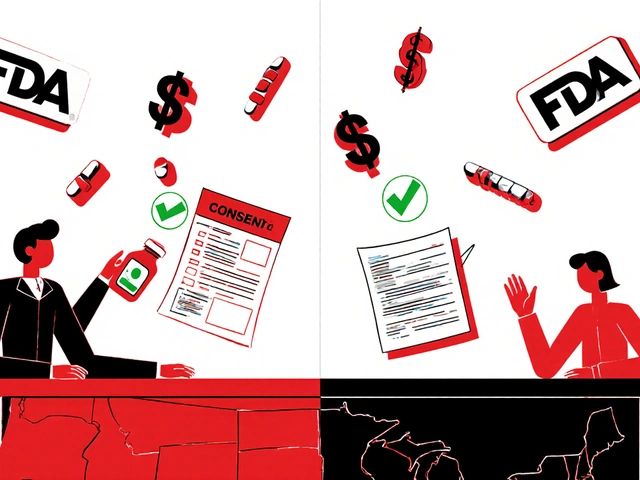When you’re taking medication for osteoporosis or cancer that’s spread to your bones, you’re focused on staying strong. But there’s a quiet, serious risk hiding in your mouth-one that many doctors and patients miss until it’s too late. Osteonecrosis of the jaw (ONJ), also called medication-related osteonecrosis of the jaw (MRONJ), isn’t something you hear about often. But when it happens, it changes everything. Exposed bone in your jaw. Pain that won’t go away. Infections that don’t respond to antibiotics. This isn’t a routine toothache. It’s bone dying because your body can’t repair itself anymore.
What Exactly Is Osteonecrosis of the Jaw?
Imagine your jawbone as a living structure. It’s constantly breaking down old bone and building new bone-like a city repairing its roads. Medications like bisphosphonates (Fosamax, Boniva, Reclast) and denosumab (Prolia) stop that process. They’re great for preventing fractures, but they also freeze bone in place. Without repair, even small injuries-like a tooth extraction or ill-fitting denture-can’t heal. The bone dies, breaks through the gum, and stays exposed for weeks or months. That’s MRONJ.
The condition is rare. For someone taking oral bisphosphonates for osteoporosis, the risk is about 1 in 10,000 to 1 in 100,000 per year. But for cancer patients on monthly IV zoledronate? The risk jumps to 1 in 10 or even 1 in 100. That’s not a small number when you’re already fighting a serious illness.
These Are the Real Warning Signs (Not Just a Toothache)
Most people think jaw pain means a cavity or gum infection. It might be-but if you’re on one of these medications and the pain doesn’t go away after a week or two, you need to look deeper. Here’s what actually signals MRONJ:
- Exposed bone-You can see or feel bone sticking out through your gums, especially after a tooth is pulled. This is the defining sign. No gum covering it. Ever.
- Pain or swelling-Not just around one tooth. A dull, constant ache in your jaw that gets worse over time. Around 87% of cases start with this.
- Poor healing after dental work-You had a tooth out, and the socket hasn’t closed in 8 weeks. That’s not normal. Normal healing takes 2-4 weeks. If it’s still open, it’s a red flag.
- Loose teeth-No trauma, no gum disease, but teeth suddenly feel wobbly. The bone holding them is dying.
- Pus or foul taste-Your gums bleed, ooze, or smell bad. Antibiotics might help temporarily, but the problem keeps coming back because the root cause isn’t infection-it’s dead bone.
- Numbness or heaviness-Like your jaw is full of concrete. This happens in 42% of cases and is often mistaken for a nerve issue.
These signs don’t show up overnight. They creep in. And that’s why so many people are misdiagnosed. One patient on a patient forum said, “My dentist gave me antibiotics three times before anyone looked at the bone.” That’s the pattern.
Which Medications Are the Biggest Risk?
Not all drugs carry the same danger. The risk depends on the drug, how it’s given, and how long you’ve been taking it.
- IV bisphosphonates (zoledronate, pamidronate)-Used for cancer that’s spread to bone. Highest risk. Monthly infusions. 1-10% chance of ONJ.
- Oral bisphosphonates (alendronate, risedronate, ibandronate)-Used for osteoporosis. Very low risk. 0.001-0.01%. But the longer you take them, the higher the risk. After 3-4 years, it starts climbing.
- Denosumab (Prolia)-Given as a shot every 6 months. Risk similar to IV bisphosphonates. It works differently but has the same effect: stops bone repair.
- Romosozumab-Newer osteoporosis drug. Less data, but early cases reported. Watch closely.
Here’s the hard truth: if you’re on IV bisphosphonates, you’re in the high-risk group. If you’re on oral bisphosphonates for 5+ years, you’re no longer in the “very low risk” zone. And if you’re about to start any of these drugs? You need to act before you take the first pill.

What Triggers It? (It’s Not Just Tooth Extractions)
People think only major dental work causes ONJ. That’s wrong. Yes, tooth extraction is the most common trigger-3.2% of people on bisphosphonates develop ONJ after one. But here’s what you might not know:
- Dentures that rub or don’t fit can cause pressure sores that turn into exposed bone.
- Even aggressive brushing or flossing can create tiny wounds that don’t heal.
- Root canals or gum surgery can also trigger it-though less often.
- And yes, it can happen with no dental work at all. About 15-20% of cases appear spontaneously.
What makes it worse? Diabetes, smoking, poor oral hygiene, and steroid use. If you have any of those, your risk isn’t just higher-it’s much higher.
How to Prevent It (Before It Starts)
Prevention isn’t complicated. It’s just not done often enough.
If you’re about to start IV bisphosphonates or denosumab for cancer:
- Get a full dental exam 4-6 weeks before your first infusion.
- Get any problematic teeth pulled before treatment starts. Waiting until after is dangerous.
- Fix crowns, fillings, and dentures. No loose or sharp edges.
- Start using chlorhexidine mouthwash (0.12%) twice a day. It cuts your risk by 37%.
If you’re on oral bisphosphonates for osteoporosis:
- See your dentist once a year. Tell them exactly what meds you’re on.
- Don’t skip cleanings. Routine scaling and polishing don’t increase risk.
- If you need a tooth pulled, talk to your doctor. For oral bisphosphonates, a 2-3 month pause isn’t usually needed-but your dentist should know you’re on them.
Here’s what patients who avoided ONJ all have in common: they had their teeth checked before starting meds. 92% of them stayed healthy. Those who didn’t? Most ended up in surgery.

What Happens If It’s Not Caught Early?
Early MRONJ (Stage 1) is treatable. Antibiotics, mouth rinses, and minor cleaning can help the bone heal. But if it’s ignored, it progresses. Bone fragments break off. Infections spread. You might need part of your jaw removed. Recovery takes months. You could lose teeth. Your face could change. And you’ll be on antibiotics for life.
There’s new hope: teriparatide (Forteo), a bone-building drug, has helped 78% of early-stage patients heal in clinical trials. But it’s not for everyone. The key is catching it before it’s too late.
Why Most People Miss the Signs
It’s not your fault. Most dentists don’t ask about your meds. Most doctors don’t warn you. A 2022 study found only 68% of private dental practices screen patients for bisphosphonate use. In academic centers? 94%. That’s a huge gap.
Patients report the same thing: “My dentist never asked.” “I didn’t know my osteoporosis pill could hurt my jaw.” “I thought it was just a bad infection.”
The FDA has required drug labels to include ONJ warnings since 2021. But warnings on a pill bottle don’t help if no one talks about them.
What You Need to Do Right Now
If you’re on any of these drugs, here’s your checklist:
- Check your mouth. Do you see any bone? Any sores that won’t heal?
- Call your dentist. Say: “I’m on [medication name]. Can we check for signs of jawbone damage?”
- If you’re about to start IV therapy, schedule a dental visit now. Don’t wait.
- Start using chlorhexidine mouthwash if your dentist recommends it.
- Keep a record of your meds and share it with every doctor and dentist you see.
This isn’t about fear. It’s about control. You’re taking these drugs to protect your body. Don’t let your mouth become the weak spot. A quick dental check could save you from years of pain, surgery, and loss.
Can osteonecrosis of the jaw happen without dental work?
Yes. About 15-20% of MRONJ cases occur without any recent dental procedure. It can start from minor trauma like ill-fitting dentures, aggressive brushing, or even natural bone stress. The key factor isn’t the trigger-it’s the impaired healing caused by the medication.
Is MRONJ the same as osteonecrosis from radiation therapy?
No. Radiation-induced osteonecrosis (ORN) is caused by damage from head and neck radiation, not medications. While the symptoms look similar-exposed bone, pain, infection-the causes and treatment approaches differ. ORN is more common in patients who had radiation for head and neck cancers, while MRONJ is tied to drugs like bisphosphonates and denosumab.
How long after starting bisphosphonates does MRONJ usually appear?
For oral bisphosphonates, most cases occur after 3-4 years of use. For IV bisphosphonates used in cancer, it often appears within 12 months of starting treatment-especially after a tooth extraction. The longer you’re on the drug, the higher your risk becomes.
Can I stop my osteoporosis medication to avoid MRONJ?
Don’t stop without talking to your doctor. The risk of breaking a hip or spine from osteoporosis is far greater than the risk of MRONJ. For most people on oral bisphosphonates, the benefits outweigh the risk. Prevention through dental care is safer than stopping treatment.
Are there any new treatments for MRONJ?
Yes. Teriparatide (Forteo), a bone-building drug, has shown promising results in early-stage MRONJ, with 78% of patients healing in clinical trials. Laser therapy and hyperbaric oxygen are also being studied. But the best treatment is still early detection and prevention.
Should I avoid all dental work if I’m on these medications?
No. Routine cleanings, fillings, and X-rays are safe. The danger comes from invasive procedures like extractions or implants. The key is planning. Get your mouth healthy before starting high-risk meds. If you’re already on them, tell your dentist so they can adjust their approach.






Just got my annual cleaning yesterday-told my dentist I’m on Boniva. She immediately pulled up the guidelines and said we’re doing a full scan next week. So glad I spoke up. Don’t wait until your jaw hurts.
November 18Jenny Lee